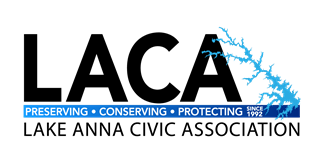By Al Bennett - March 2021
Pressure treated lumber is a ubiquitous building material used at Lake Anna in the construction of docks, decks, seawalls, retaining walls and other outdoor applications. This article provides a brief history of the preservatives used for wood treatment and provides the current standards for treated wood.
 Older members of LACA like me probably remember the time when pentachlorophenol (PCP) or creosote was used as a lumber preservative. PCP use began in 1936. PCP was found to be harmful to the liver, kidneys, blood, lungs, nervous system, immune system, and gastrointestinal tract and is classified by the EPA as a probable carcinogen. PCP was removed as a consumer product in 1987.
Older members of LACA like me probably remember the time when pentachlorophenol (PCP) or creosote was used as a lumber preservative. PCP use began in 1936. PCP was found to be harmful to the liver, kidneys, blood, lungs, nervous system, immune system, and gastrointestinal tract and is classified by the EPA as a probable carcinogen. PCP was removed as a consumer product in 1987.
Creosote used as a wood preservative is a coal-tar based chemical. It is the product I remember my family using as I was growing up. It was first used as a wood preservative in 1836 and its use as a consumer product was discontinued in 2005. Creosote is still used today as a preservative for railroad ties, utility poles, and marine pilings.
Chromated copper arsenate (CCA) treated lumber is the one most of us remember and many of us wish we could still purchase. This treated wood seemed to last forever and many decks and docks here at the Lake that were built before 2004 are still in good condition today. CCA treated lumber first came to use in the 1940s and in the period from the early 1970s until 2004, it was the go to lumber we all used for outdoor applications. This product contained arsenic and in an agreement with the EPA, the wood industry discontinued the production of CCA treated lumber for residential use.
Alkaline copper quaternary(ACQ) and Copper azole (CA) replaced CCA as the common preservatives for pressure treated lumber. Unfortunately, the downside of these preservatives is the galvanic corrosive effect of copper to other metals (e.g., aluminum, steel, and the zinc coating of galvanized nails and screws). Ceramic coated or stainless steel fasteners are required to safely build using ACQ or CA lumber.
Today, in most home centers and lumberyards, you will find lumber pressure treated with micronized copper quaternary (MCQ) or micronized copper azole (MCA). These two preservatives are similar to ACQ and CA; however, the copper is finely ground and is suspended and not dissolved in the preservative solution. Purportedly, the finely ground copper is able to penetrate the wood cells; therefore, it is less likely to leach out and corrode fasteners.
The American Wood Protection Association (AWPA) develops standards used by the wood preservative industry. For each AWPA use category (e.g. Exterior above Ground), they specify the number of pounds of a given preservative (e.g., MCA) per cubic foot that the wood must retain in order to meet the requirement of its application. For example, southern pine must retain .06 pounds of MCA per cubic foot for use in exterior above ground applications. Similarly, if southern pine is treated with MCA and it is to be used in a ground contact application, it must be treated with .15 or .31 pounds per cubic foot for general or heavy duty applications, respectively. Below is a list and brief description of AWPA use categories.
|
Use Category
|
Brief Description
|
|
UC1
|
Interior Dry
|
|
UC2
|
Interior Damp
|
|
UC3A
|
Exterior Above Ground, Coated with Rapid Water Runoff
|
|
UC3B
|
Exterior Above Ground, Uncoated or Poor Water Runoff
|
|
UC4A
|
Ground Contact, General Use
|
|
UC4B
|
Ground Contact, Heavy Duty
|
|
UC4C
|
Ground Contact, Extreme Duty
|
|
UC5A
|
Marine Use, Northern Waters (Salt or Brackish Water)
|
|
UC5B
|
Marine Use, Central Waters (Salt or Brackish Water)
|
|
UC5C
|
Marine Use, Southern Waters (Salt or Brackish Water)
|
|
UCFA
|
Interior Above Ground Fire Protection
|
|
UCFB
|
Exterior Above Ground Fire Protection
|
At the end of each pressure treated board offered for sale is a tag, similar to the picture below, which provides useful information. 
It tells you the type of preservative used, the amount retained per cubic foot, the recommended use for the treated lumber, and the AWPA use code. Make sure the wood you purchase meets AWPA standards and is of the correct use category for your project. Not all lumber yards carry lumber of every use category. The use category you want may be a special order.
